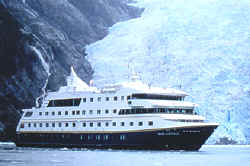

Destinations
Experiences
 |
L A
D A T C O T O U R
S |
 |
||||||||
| HOME | South America | Falkland Islands | Antarctica | Unique Destinations |
Unique Experiences |
Newsstand | ||||
|
PUNTA ARENAS |
|
Punta Arenas, southernmost city in Chile, is
gateway to the southern tip of Patagonia and to spectacular Paine Towers National Park. From Punta Arenas multiple Patagonia experiences are available:
Punta Arenas is increasingly popular as the beginning of a Patagonia circuit combining a visit to Paine Towers National Park and Parque Nacional Los Glaciares in Argentina. And Punta Arenas remains the starting point for one of the most poular Antarctica programs, Antarctica XXI, which flies over Drake Passage to King George Island and cruises from there. |
|
||||||||||||||
ABOUT SOUTHERN PATAGONIA
Technically Patagonia spans the southern third of Chile and Argentina, stretching between the Pacific and the Atlantic from roughly Puerto Montt, Chile and Peninsula Valdes, Argentina south till it meets the famous waterways of Strait of Magellan, Beagle Channel and Drake passage. On the Chilean side, the snowcapped Andes, inland fjords, rich forests and small towns dominate; on the Argentine side, huge distances and tree-less expanses dominate.
But true Patagonia is further south, encompassing the tip of the continent. This is the Patagonia most often described as wind-swept, sparsely populated, remote, and rugged. It is rich in wildlife and human history, sprinkled with sheep estancias and punctuated by national parks, towering snowcapped mountains, glistening glaciers and deep blue fjords and bays. Wide sweeping vistas of "steppes" can be broken by towering snow-capped mountains, or can go as far as the naked eye can see.
The legendary winds of Patagonia are most prevalent December through March, the height of the summer. Pack to layer clothes - even in the warmest of summer days average highs hover around 60 F and lows can dip to the low 40's F. Dress is casual at all times. Bring sun protection, good walking shoes and a small back-pack for day gear.
LAGO ARGENTINO - EL CALAFATE, ARGENTINA:
El Calafate (pop 3,000), on the south shore of Lago Argentino is a modern boom town. Many new hotels and restaurants abound and there are a variety of souvenir and outfitting shops, although with limited selection. All in all, El Calafate is a relatively small, sleepy town that thrives in the summer and practically closes down in the winter. It is also the gaterway to El Chalten and Fitz Roy in the northern part of Los Glaciares National Park..PUNTA ARENAS, CHILE:
Southernmost city in Chile, Punta Arenas (pop 110,000) lies on the eastern shore of the Brunswick Peninsula facing the Strait of Magellan, equal distance from the Pacific and the Atlantic. Founded in 1848, Punta Arenas was a thriving major port for steam ships and whaling vessels rounding the Cape until the opening of the Panama Canal in 1914. It is the center for local sheep farming and fishing industries and home to La Polar, the most southerly brewery in the world. The Salesman Museum has an outstanding display on indigenous peoples; the Patagonia Institute is an open air museum with artifacts from the early settlers. The penguin rookery (Oct-Mar) is an hour's drive from town + 1 mile walk each way.
 |
THE AUSTRALIS COLLECTION Sailing from Punta Arenas on twice a week September through March, the sister ships Ventus Australis and Stella Australis sail the famed Strait of Magellan, Beagle Channel and spectacular Glacier Alley with ports of call at Port Williams and Ushuaia and a stop at Cape Horn National Park. Eco-walks, glacier visits, on-board lectures and educational briefings are the highlight of these expedition cruises, the only cruise of its kind. |
PAINE TOWERS NATIONAL PARK, CHILE:
Covering 181,414 hectares, Paine Towers park has over 15 peaks between 6,000 and 10,000 feet tall, but is dominated by the triple spikes of the Horns of Paine (Torres del Paine) Lakes, valleys, 6 glaciers, icefields and superb wildlife including 105 species of birds, 25 species of mammals, 200 species of plants make Paine spectacular. Bring good walking shoes, sun protection and a hat and be sure to layer clothing.There are hotels in the park, such as Las Torres and on the edge of the park, including the luxury yurt-style Patagonia Camp, and new properties adding the culture of Patagonia to the activities of Patagonia: The Singular Patagonia at Puerto Bories and Tierra Patagonia as well as the all-private villa-style Awasi Patagonia.
Map of hotel locations
| Hotel
Explora en Patagonia, Paine Towers National Park One of the most popular ways to visit Paine Towers National Park is the Hotel Explora in Patagonia, an all-inclusive edge-of-luxury 50-room hotel overlooking Salto Chico with a selection of activities such as hiking and horseback riding. |
PUERTO NATALES, CHILE:
Three hours drive north of Punta Arenas, two hours south of Payne Towers, Puerto Natales (pop 15,000) and on the Ultima Esperanza gulf amid spectacular scenery. A good walk will take you up Cerro Dorotea for superb views of the town. On the shores of the Ultima Esperanza is Remota, a lodge offering all-inclusive programs with varied activities in and around the park.
USHUAIA, ARGENTINA:
Southernmost city in the world-fabled Tierra del Fuego, Ushuaia (pop 30,000) climb steeply from the Beagle Channel up Cerro Martial, with residential areas occupying the higher levels of town. Ushuaia is one of the more expensive cities due to transportation of essentials.